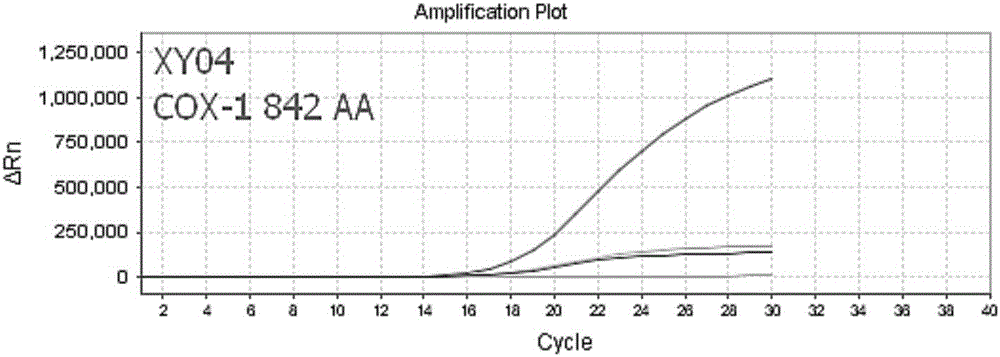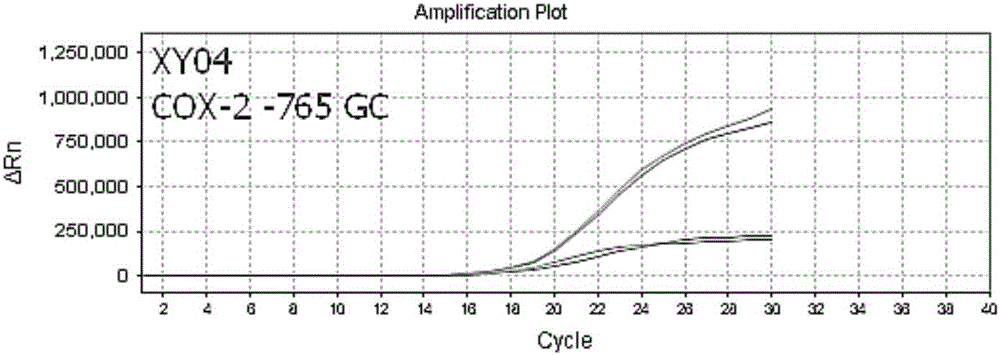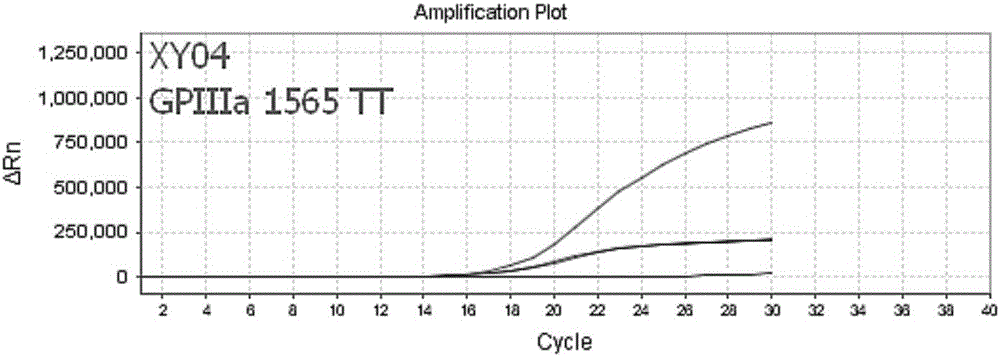Nucleic acid, kit and method used for detecting polymorphism of COX-1, COX-2 and GPIIIa genes
A gene polymorphism, COX-1 technology, applied in biochemical equipment and methods, microbial determination/inspection, DNA/RNA fragments, etc., can solve the problems of cross-contamination of PCR products, insufficient enzyme digestion, and complicated steps. , to avoid the problem of non-specific amplification, the detection results are reliable, and the effect of overcoming easy contamination
- Summary
- Abstract
- Description
- Claims
- Application Information
AI Technical Summary
Problems solved by technology
Method used
Image
Examples
Embodiment 1
[0072] Embodiment 1 primer, probe, verification template design
[0073] The specific principle of the present invention is: design wild-type and mutant ARMS primers and Taqman-MGB probes respectively for different gene loci, and combine with fluorescent quantitative PCR reaction to detect genomic DNA extracted from human peripheral blood cells or oral swabs , which can realize the detection of cyclooxygenase 1 (COX-1) gene A842G, cyclooxygenase 2 (COX-2) gene G-765C and platelet membrane glycoprotein (GPIIIa) gene in one 6-way PCR reaction strip at one time The gene polymorphism of T1565C is detected, and the genotype of the sample DNA is determined by collecting signals on a real-time fluorescent PCR instrument and calculating the ΔCt values of the wild type and the mutant type.
[0074] Design wild-type upstream primers, mutant upstream primers, public downstream primers and public detection probes for the A842G site of the human COX-1 gene, the G-765C site of the COX-2 g...
Embodiment 2
[0092] Example 2 Method for detecting COX-1, COX-2 and GPIIIa gene polymorphisms by real-time fluorescent PCR
[0093] The wild-type upstream primers, mutant upstream primers, public downstream primers and public detection probes of each gene screened and designed in Example 1 were synthesized, and a fluorescent group was connected to the 5' end of the detection probe, and a quencher was connected to the 3' end. Group, wherein, the fluorescent group can be any one of FAM, JOE, CY3, HEX, and the quenching group can be any one of MGB, BHQ1, TAMRA, BHQ2.
[0094] A method for detecting polymorphisms of COX-1, COX-2 and GPIIIa genes by real-time fluorescent PCR. Specific steps are as follows:
[0095] (1) Obtain the DNA of the sample to be tested;
[0096] (2) Apply the designed detection primers and detection probes to perform real-time fluorescent PCR amplification detection on the A842G, G-765C, and T1565C polymorphisms of the COX-1, COX-2, and GPIIIa genes in the DNA of the ...
Embodiment 3
[0122] Embodiment 3 is used for detecting the kit of COX-1, COX-2 and GPIIIa gene polymorphism
[0123] The real-time fluorescent PCR kit for detecting polymorphisms of COX-1, COX-2 and GPIIIa genes includes the following components:
[0124] COX-1 gene A842G wild-type primer pair: the nucleotide sequences are shown in SEQ ID NO.1 and SEQ ID NO.3;
[0125] COX-1 gene A842G mutant primer pair: the nucleotide sequences are shown in SEQ ID NO.2 and SEQ ID NO.3;
[0126] COX-1 gene A842G detection probe: the nucleotide sequence is shown in SEQ ID NO.4;
[0127] COX-2 gene G-765C wild-type primer pair: the nucleotide sequences are shown in SEQ ID NO.5 and SEQ ID NO.7;
[0128] COX-2 gene G-765C mutant primer pair: the nucleotide sequence is shown in SEQ ID NO.6, and the downstream primer is shown in SEQ ID NO.7;
[0129] COX-2 gene G-765C detection probe: the nucleotide sequence is shown in SEQ ID NO.8;
[0130] GPIIIa gene T1565C wild-type primer pair: the nucleotide sequences...
PUM
 Login to View More
Login to View More Abstract
Description
Claims
Application Information
 Login to View More
Login to View More - R&D
- Intellectual Property
- Life Sciences
- Materials
- Tech Scout
- Unparalleled Data Quality
- Higher Quality Content
- 60% Fewer Hallucinations
Browse by: Latest US Patents, China's latest patents, Technical Efficacy Thesaurus, Application Domain, Technology Topic, Popular Technical Reports.
© 2025 PatSnap. All rights reserved.Legal|Privacy policy|Modern Slavery Act Transparency Statement|Sitemap|About US| Contact US: help@patsnap.com



